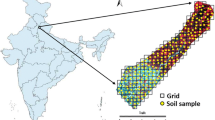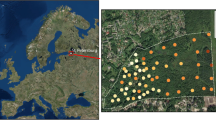Abstract
Increasingly, soil surveys make use of a combination of legacy data, ancillary data and new field data. While combining the different sources of information, positional errors can play a large role. For example, the spatial discrepancy between remote sensing images and field data can depend on many factors, including the positioning accuracy of ground-based observations. The accuracy of GPS receivers for the territory of Russia is approximately 3–10 m. The aim of the study was to estimate the impact of sampling positioning accuracy on the relationship between soil organic carbon content and the infrared channel of the WorldView-2 satellite image and for mapping soil organic carbon contents in an agricultural field in the territory of the Bryansk Opolje (Russia). Intensive sampling of the topsoil took place. The positional accuracy was also measured and used to perturb the locations of the samples. The data were used to study: (i) the relationships between soil organic carbon and infrared reflectance, (ii) the variation in soil organic carbon through five different interpolation techniques, and (iii) the fraction of the fields with low soil organic matter contents. The study showed that the positional inaccuracies can have an important impact. The standardized methods to estimate the positional accuracy, perturb the locations and evaluate its impact seems to be an easy way to explore the quality of data.








Similar content being viewed by others
References
Alifanov, V. M., Gugalinskaya, L. A., Ivannikova, L. A., & Ovchinnikov, A Yu. (2006). Soil polygenesis in the northeast part of Vladimir Opolie. Eurasian Soil Science, 39, s31–s39. https://doi.org/10.1134/S1064229306130072.
Bartholomeus, H. M., Schaepman, M. E., Kooistra, L., Stevens, A., Hoogmoed, H. M., & Spaargaren, O. S. P. (2008). Spectral reflectance based indices for soil organic carbon quantification. Geoderma, 145, 28–36.
Carré, F., McBratney, A. B., & Minasny, B. (2007). Estimation and potential improvement of the quality of legacy soil samples for digital soil mapping. Geoderma, 141, 1–14.
Chen, F., Kissel, D. E., West, L. T., Rickman, D., Luvall, J. C., & Adkins, W. (2005). Mapping surface soil organic carbon for crop fields with remote sensing. Journal of Soil and Water Conservation, 60, 51–57.
Christy, C. D., Drummond, P., & Laird, D. A. (2003). An on-the-go spectral reflectance sensor for soil. Paper number 031044, St Joseph, MI, USA: ASAE
Cressie, N., & Kornak, J. (2003). Spatial statistics in the presence of location error with an application to remote sensing of the environment. Statistical Science, 18(4), 436–456.
Egorov, V. V., Fridland, V. M., Ivanova, E. N., Rozov, N. N., Nocin, V. A., & Friev, T. A. (1977). Classification and diagnostics of soils of the USSR. Moscow, Russia: Kolos. [in Russian].
Fisher, P. (1997). The pixel: a snare and a delusion. International Journal of Remote Sensing, 18(3), 679–685.
Grimm, R., & Behrens, T. (2010). Uncertainty analysis of sample locations within digital soil mapping approaches. Geoderma, 155(3–4), 154–163.
Henderson, T. L., Baumgardner, M. F., Franzmeier, D. P., Stott, D. E., & Coster, D. C. (1992). High dimensional reflectance analysis of soil organic matter. Soil Science Society of America Journal, 56, 865–872.
IUSS Working Group WRB (2015). World reference base for soil resources 2014, update 2015. International soil classification system for naming soils and creating legends for soil maps. In World Soil Resources Reports No. 106. Rome, Italy: FAO.
Ladoni, M., Bahrami, H. A., Alavipanah, S. K., & Norouzi, A. A. (2010). Estimating soil organic carbon from soil reflectance: a review. Precision Agriculture, 11, 82–100.
Milkov, F. N. (1964). About the nature of opoljes of russian plain. Voprosy regionalnogo landshaftovedenia i geomorphologii SSSR, 8, 20–27. [in Russian].
Mulder, V. L., de Bruin, S., Schaepman, M. E., & Mayr, T. R. (2011). The use of remote sensing in soil and terrain mapping—a review. Geoderma, 162, 1–19.
Mulders, M. A. (1987). Remote sensing in soil science. In Developments in Soil Science. Amsterdam, The Netherlands: Elsevier.
Shishov, L. L., Tonkonogov, V. D., Levedeva, I. I., & Gerasimova, M. I. (2004). Soils classification and diagnostics of Russia. Moscow, Russia: Dokuchaev Soil Science Institute. [in Russian].
Stoorvogel, J. J., Kooistra, L., & Bouma, J. (2015). Chapter 2: Managing soil variability at different spatial scales as a basis for precision agriculture. In R. Lal & B. A. Stewart (Eds.), Soil-specific farming: Precision agriculture, Advances in soil science (pp. 37–71). Boca Raton: CRC Press, Taylor Francis Group.
Velichko, A. A., Morosova, T. D., Nechaev, V. P., & Porogeniakova, O. M. (1996). Palaeocryogenesis, soil cover, and farming. Moscow, Russia: Nauka. [in Russian].
Wu, J., Jones, K. B., Li, H., & Loucks, O. L. (2006). Scaling and uncertainty analysis in ecology: methods and applications. New York: Springer.
Zavarzina, A., Rozanova, M., & Sukhanova, N. (1996). Humus content and reflectivity of upper horizons of soils of the southern regions of European Russia. Eurasian Soil Science, 28(11), 349–360.
Acknowledgements
This study has been performed with support by grant #14-120-14-4266-ScSh and by Grant according to the Agreement No. 02.A03.21.0008 of the Russian Federation Ministry of Education and Science, Grant #ScSh-10347.2016.11 of the Leading Scientific Schools, EU’s FP7 grant agreement #603542 (the Project LUC4C) and Grant # 15-16-30007 of the Russian Science Foundation. We are especially grateful to the anonymous referees for their careful reading and valuable comments, which have greatly improved the paper.
Author information
Authors and Affiliations
Corresponding author
Rights and permissions
About this article
Cite this article
Samsonova, V.P., Meshalkina, J.L., Blagoveschensky, Y.N. et al. The role of positional errors while interpolating soil organic carbon contents using satellite imagery. Precision Agric 19, 1085–1099 (2018). https://doi.org/10.1007/s11119-018-9575-4
Published:
Issue Date:
DOI: https://doi.org/10.1007/s11119-018-9575-4




